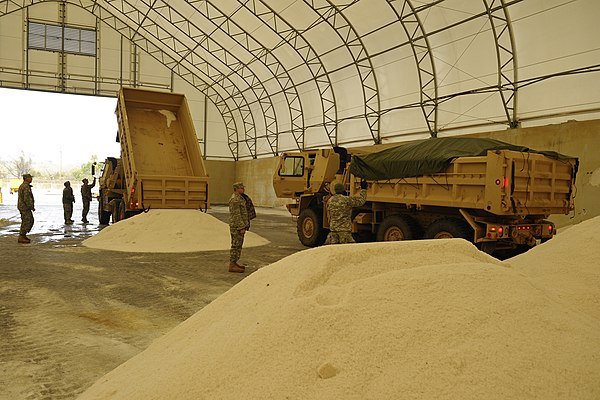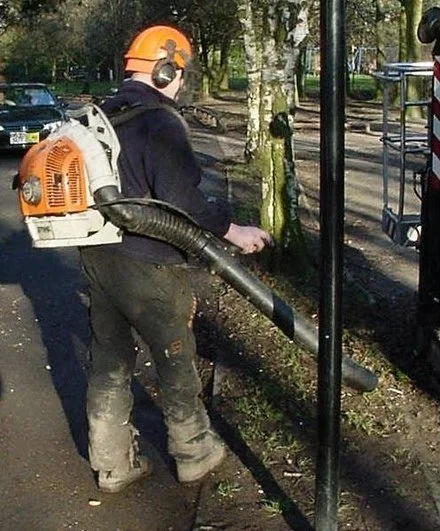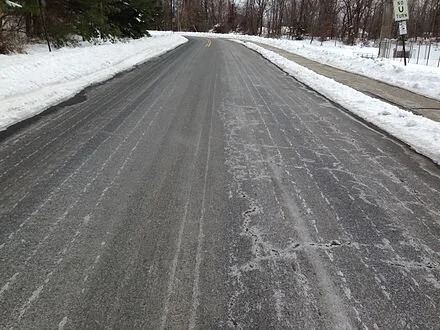
Local but national, too
Road salt distribution center
Odds and ends from Robert Whitcomb’s “Digital Diary,’’ in GoLocal24.com
Providence and some other communities are dumping far too much salt on some streets, some of which were bright white with it last week, amidst drifts of salt pebbles. This is toxic to plant life and pollutes water supplies. More care, please.
xxx
Is it fair to make teachers at, say, Barrington High School have three COVID shots as a condition of employment while a few dozen students are allowed to attend completely unvaccinated?
While at work, he makes a neighborhood miserable.
Kudos to Rhode Island state Sen. Samuel Zurier, of Providence, for introducing a bill to phase out those shrieking and intensely polluting gasoline-powered leaf blowers that make life miserable for humans and other animals for weeks at a time. They’re often wielded by hard-working illegal aliens with no ear protection working for yard crews. Somehow we survived quite well without them for millennia.
Besides the much quieter electric leaf blowers, there’s that revolutionary device called the rake. A few decades ago, I and other teens made extra spending money raking, lawn mowing and hedge-clipping. Where oh where did those healthy gigs go? Why do so many affluent people feel that they must hire a “landscaping company.’’
Grace Kelly: The heavy side-effects of salting roads
This road has been treated with salt brine.
From ecoRI News (ecori.org)
Winter is here, and with it the tried and true method for keeping roads from becoming slippery: salt.
Salting roads as a method of preventing ice from forming began in 1938 in New Hampshire and has become the go-to method for safe winter driving. It’s effective. According to a 1992 study from Marquette University, salting the roads reduced winter car accidents by 87 percent.
While it’s an effective method for safer winter driving, throwing tons of salt down comes with side effects. When cavalries of trucks start to season the roads, they also inadvertently contaminate freshwater wetlands.
“Road salt can travel up to 170 meters [558 feet] from the road across the landscape into wetlands like vernal pools,” said Nancy Karraker, an associate professor of wetland ecology and herpetology at the University of Rhode Island.
Karraker has been studying the impacts of road salt on vernal pools and freshwater wetlands for years and has concerns about salt’s effects on the invertebrates that make fresh water their home.
“Through experiments, I found that wood frogs’ eggs and their tadpoles were only affected at the highest salinity concentration, so they were a little bit more resilient,” she said. “But with the spotted salamanders, there was a significant decline in survival of both eggs and tadpoles with the average concentration of salt we were seeing at vernal pools near roads.”
And getting an average, or even high, concentration of salt in the water is easier to do than you might think.
“If you think about the head of a penny, if you cover half of the head of that penny with rock salt, dump that into a quart of water and stir it until it dissolves, that’s the salt concentration that is harmful to spotted salamanders,” Karraker said. “And if you completely cover the head of a penny and let a little bit spill over the side, and dump that in a quart of water, that’s the amount that harms wood frogs. So it’s a tiny amount of salt, it’s a very low concentration that impacts these animals.
Rhode Island doesn’t just use a pinch of salt to season its roads. From 2005 to 2013, Rhode Island roads received an average of 516 pounds of salt per lane mile annually, according to a 2014 report by the Rhode Island Department of Administration’s Division of Planning.
Nationwide, an estimated 10 million to 20 million tons of salt is dumped on roads annually — about 120 pounds for every American. Though many states, including Rhode Island, are turning to brine — a mixture of water and salt — instead of chunky crystals, for Karraker a salt by any other name still tastes as salty.
“A salt is a salt is a salt — it doesn’t matter if you’re talking about sodium chloride, magnesium chloride, potassium chloride, and brining just means that you’ve got a salt solution that’s been diluted a bit with water so you can spray it on the road so it acts more quickly to limit ice buildup.”
Karraker hopes that the state departments of environmental management and transportation will consider having “no salt” designations for roads that are near freshwater wetlands.
“You see these signs that say, ‘low road salt use’ near public drinking water sources and I wish they would do the same for biodiversity,” she said. “Why couldn’t we designate certain roads around our wildlife management areas as low road salt use areas to protect biodiversity? Why can’t we start to think about protecting biodiversity like we think about protecting our drinking water? I think it’s important.”
Thanks for this important and timely article. Don't forget about the impact of road salts on our groundwater! Just in case amphibians or infrastructure don't motivate us, this story eventually comes full circle through our wells, drinking water, and back to us. Our state needs a coherent database of wells contaminated with road salts! We also need to be exploring other solutions to safer winter driving....
Grace Kelly is an ecoRI News journalist.
Another woe from tough winter: road salt in steams and ponds
By ecoRI News staff
The salt and sand used to treat roadways during this snowy winter are likely to have a negative impact on the water quality in local lakes, ponds and streams this year.
“All that salt is going to lead to increased chloride in our waterways, which isn’t good for the critters that live in our streams and lakes,” said Elizabeth Herron, the University of Rhode Island’s Watershed Watch program coordinator. “It’s increasingly becoming an issue across the entire northern tier of states, and it’s liable to be very evident this year.”
The runoff of sand from roadways poses a different kind of problem. It creates what Herron calls “sand fans” in water bodies, changing the depth of lakes and providing habitat for invasive plants that prefer shallower water. Sand also can smother the eggs of bottom-dwelling creatures.
“The big storm events that we’ve been seeing in recent years are also generating more runoff and more chances for pollutants to get into lakes, streams and Narragansett Bay,” Herron said.
About 350 Watershed Watch volunteers monitor the water quality in 220 lakes, ponds, streams, bays and other water bodies in Rhode Island. They play a critical role in helping scientists understand the effect that weather and land use have on water quality.
Analysis of the 27 years of data collected by program volunteers has identified changes in water temperature, nutrients, bacteria, algae and other factors that affect the health of aquatic ecosystems.
“Temperature is a particularly important factor,” Watershed Watch director Linda Green said. “Things happen faster at higher temperatures, and certain plants and animals can’t survive when it’s too warm. And certain algae, especially the bad ones, love the high temperatures. So being able to document temperature trends may help us predict problems in the future.” Classroom training for new volunteers will take place at URI’s Kingston campus on March 25 at 6 p.m. and repeated March 29 at 1 p.m., with field training scheduled for Saturdays in April.
Volunteers come from all walks of life and are of all ages, occupations, educational backgrounds and interests. Each volunteer is matched to a specific location that they will be in charge of monitoring. Once a week on a day of their choice, volunteers monitor for water clarity and temperature. Every two weeks they also monitor algae concentrations and dissolved oxygen.
On several designated dates, volunteers collect water samples that are analyzed at URI for nutrients, acidity and bacteria. Many volunteers work in teams to share their monitoring duties.
Ponds, lakes and some saltwater sites are monitored at their deepest point, so access to a boat, canoe or kayak is necessary. But few river and stream sites require a boat.
“The water quality information collected by our volunteers is used by conservation organizations, policymakers, regulators, and state and local officials to make decisions that improve and protect the health of local waters,” Green said. “It is also used by the Rhode Island Health Department to study the connection between increased water temperatures and the health of Rhode Islanders.”
For more information or to register for the training sessions, contact Elizabeth Herron at 401-874-4552 or at emh@uri.edu.


